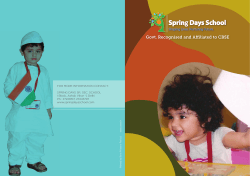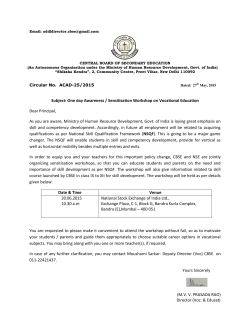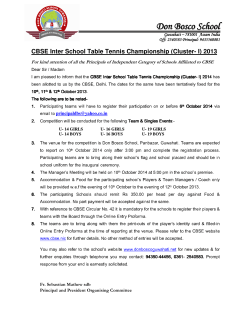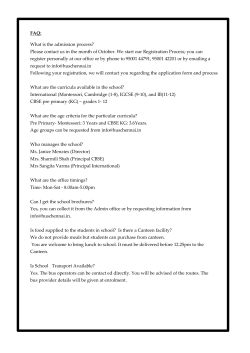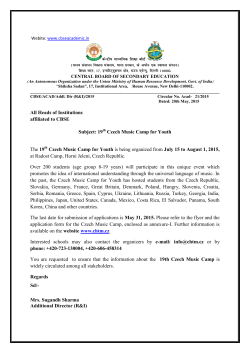
class 12th economics unsolved sample paper cbse 2015
CBSE SAMPLE PAPER 4 (Unsolved) ECONOMICS Class – XII Time allowed: 3 hours Maximum Marks: 100 General Instructions: a) All questions are compulsory. b) The question paper comprises of two sections, A and B. You are to attempt both the sections. c) Questions 1 to 5 in section A and 16 to 18 in section B are MCQ’s of one mark each. Choose the correct option. d) Questions 6 to 8 in section A and 19 to 23 in section B are three marks questions. These are to be answered in about 30 words each. e) Questions 9 to 11 in section A and 24 to 25 in section B are four marks questions. These are to be answered in about 50 words each. f) Questions 12 to 15 in section A and 26 to 29 in section B are six marks questions. These are to be answered in about 70 words each. Section A Q1. Q2. The central problem of what to produce refers to: a) Which technique be adopted b) who are the consumers c) which good to produce d) All of the above. What is the curve showing the relationship between quantity demanded and price of a commodity known as: Q3. Q4. Q5. a) Demand curve b) production possibility curve c) Indifference curve d) None of the above Suppose 10,000 laborers migrate to India. India’s PPC would move: a) To the right b) to the left c) Does not change d) None of the above In economics, equilibrium means: a) More should be produced b) less should be produced c) position of no change d) None of the above. When Marginal utility is negative, total utility: a) Falls b) Rises c) Reaches maximum d) None of the above. Material downloaded from http://myCBSEguide.com and http://onlineteachers.co.in Portal for CBSE Notes, Test Papers, Sample Papers, Tips and Tricks Q6. Explain the relationship between marginal revenue and total revenue with the help of a revenue schedule and diagram. Q7. What does microeconomics deal with? Give examples. Q8. Explain any three determinants of supply of a commodity. Q9. When is the demand for a commodity said to be (a) elastic (b) inelastic (c) unitary elastic. Q10. A firm is working under conditions of perfect competition in the market where the prevailing price of its product is Rs 16 per unit. What will be the firm’s total revenue, average revenue and marginal revenue as the firm expands its output from 1 to 5 units? Q11. Given the market price of a good, how does a consumer decide as to how many units of that good to buy? Explain. Q12. How will an increase in income of the buyer of an inferior good affect its equilibrium price and quantity? Explain with the help of the diagram. Q13. Explain various categories of price elasticity of supply. Use diagram. Q14. Briefly explain any four factors that lead to an increase in demand. Q15. Define Budget Line and explain how is it derived? SECTION B Q16. Which of the following should be included in final expenditure: a) Expenditure on gifts and donations b) expenditure on intermediate goods c) expenditure on purchase of new scooter d) none of the above. Q17. The money value of final goods and services produced by all the nationals of the country living in and outside the country is known as: Q18. Q19. a) GNP b) NNP c) GDP d) None of the above. Which of the following is an instrument of monetary policy? a) Bank rate b) open market operations c) cash reserve ratio d) all of the above. Distinguish between marginal propensity to consume and marginal propensity to save. What is the relation between the two? Q20. Explain the three methods of looking at national income. Q21. Show how the sum of value added is equal to the sum of factor income. Material downloaded from http://myCBSEguide.com and http://onlineteachers.co.in Portal for CBSE Notes, Test Papers, Sample Papers, Tips and Tricks Q22. Suppose the economy is in the grip of recession. To overcome this, the government undertakes a new investment of Rs 500 crores. How much national income will be increased if the marginal propensity to consume of the society is 0.75? Q23. Derive the multiplier when MPC is (i) 0.90 (ii) 0.75 Q24. Explain the ‘unit of value’ function of money. Q25. What is meant by fiscal deficit? What problems can fiscal deficit create for an economy? Q26. How will you derive personal disposable income from national income? Q27. Do you consider a commercial bank ‘creator of money’ in the economy? Explain. Q28. Why must aggregate demand be equal to aggregate supply at the equilibrium level of income and employment? Explain with the help of a diagram. Q29. Why does the demand for foreign exchange rise when its price falls? Material downloaded from http://myCBSEguide.com and http://onlineteachers.co.in Portal for CBSE Notes, Test Papers, Sample Papers, Tips and Tricks
© Copyright 2025





